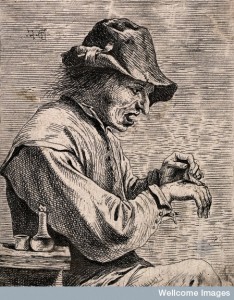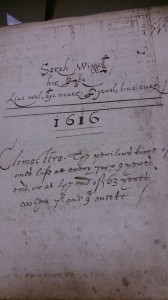
Last summer I spent a few days in the Somerset Heritage Centre, Taunton, reading the casenotes of John Westover, a surgeon – or by the looks of his practice, general practitioner operating in and around Wedmore in the late seventeenth century. Having finished going through the casenotes I took the opportunity to have a look at a couple of the recipe books housed in the archive. One of these is dated to the late seventeenth – early eighteenth century, but has no names ascribed to it. The book is organised (approximately) head to toe and includes remedies for shortness of breath, webs in the eyes, and sciatica, amongst other things.

The most intriguing recipe though appears towards the back of the book in a section providing remedies for the running of the reines, menstrual problems and venereal disease. Unlike the rest of the book the remedies for menstrual problems and venereal disease are partially hidden by the use of Latin, or Latin-ish, titles: ‘Pro Menstuord Irritationes’, ‘Ad reprimanda Menstruate’, ‘pro Morbo Gallico if it be broken’. These titles are sometimes interpreted as a means of filtering readers of the text, so that only those with a Latin education would know what the remedies are for. However given that Morbus Gallicus was a widely circulated name for the venereal disease, it is questionable how far this strategy would have hidden the intended purpose of the remedy.1 Meredith Ray has instead suggested that Latinised and partially encrypted titles given to remedies for sexual function might actually have served not to ‘restrict the flow of information’ but to ‘highlight the unique and precious nature of the remedy’.2 Latin elevate a remedy and signify its value.3
Following these delightfully titled recipes the author lists ‘A Plaster to know whether a sore be Morbus Gallium or not’:
Take the fatt of Adders or Snakes , or for want of them, of the fatt of fresh [b]eetles and Butter if in winter 2 ounces in Simmer but one, of Turpentine an ounce, of Romine an ounce, mix all together and make a plaster thereof, then applye it to the sore, it healeth very gently: But if you wil healed it soone, though with much paine, you must add to the aforesaid things an ounce of verdigrease, And if it be Mobs Gallium when the plaster is taken off it will looked white, otherwise it will change its former colour which is greene.4
The author of this remedy doesn’t say how long the patient should wait before taking a peek under the plaster to see whether or not it had changed colour. Nor do they say what should be done next, although presumably the appearance of white residue signalled the necessity for further treatment. Either way I imagine it was an anxious wait for anyone applying this remedy to a suspicious sore. Medical texts noted lengthy lists of symptoms for the venereal disease, and some included the importance of pustules and sores for identifying the pox. Daniel’s Sennert’s treatise of the Pox claimed that ‘the venereal pustles are some of them crusty, others without a crust, the crusty are chiefly the signs fo this disease’.5 But he didn’t offer a method for testing sores to verify their cause.
______________________
1 The recipe collection in the Evelyn papers also used Morbus Gall to describe a remedy for venereal disease and in another instance simply states ‘pox’ as a title. British Library Add MS 78337 Evelyn papers, Sig. 9r.
2 Meredith K. Ray, ‘Impotence and Corruption: Sexual Function and Dysfunction in Early Modern Italian Books of Secrets’, in Sara F. Matthews-Grieco (ed.), Cuckoldry, Impotence and Adultery in Europe (15th -17th century), (Farnham, 2014), 125-146 at p.131.
3 Ibid, p.131.
4. Somerset Heritage Centre, DD/X/FW1 C/1751.
5. Daniel Sennet, Two Treatises. The First of the Venereal Pocks (London, 1660), p.22.





2 thoughts on “Have you got the Pox?”
Comments are closed.